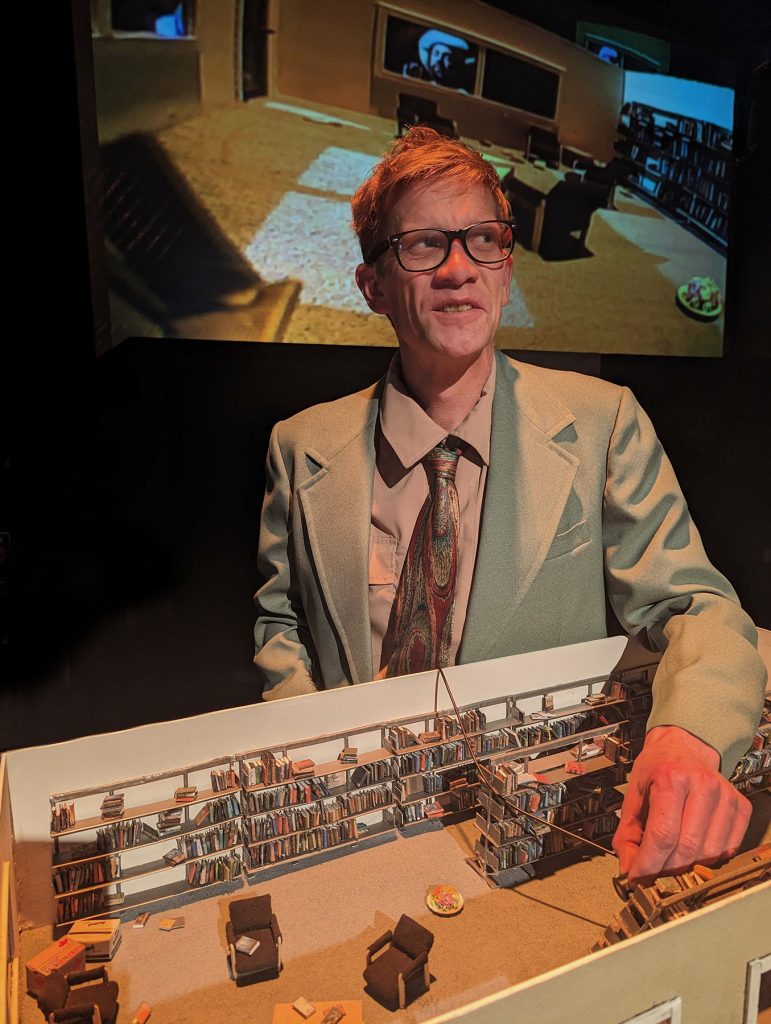The play digs into a big bag of ideas, jokes, images, pop culture knick-knacks and historical archives
It doesn’t seem fair or smart or particularly nimble to write that the folks at Buntport are at it again. And yet: The folks at Buntport are at it again with their latest original play, “Best Town.” By “it” I mean digging into a big bag of ideas, jokes, images, pop culture knick-knacks and historical archives to craft a witty, intellectually omnivorous bit of business that dares to be silly, too.
It’s hard not to detect an echo of Thornton Wilder’s “Our Town” in the title of this larky, post-pandemic dive into the subjects of loneliness and connection — and, oh yeah, libraries, Olivia Newton-John and Thomas Pynchon. Only the burg here, Kitsault, is an abandoned mining town in Canada, about 17 hours northeast via the Cariboo Highway from Vancouver, B.C. And its denizens are a goofy little trio of caretakers: groundskeeper Dodge (Brian Colonnacq), interior-buildings steward Stanley (Erik Edborg), and emergency go-to Hilary (Erin Rollman), who has decided to be the town’s videographer and marketer.
Somewhere nearby they’ve spied another person, and refer to her as Number Four. Hannah Duggan plays the mine monitor, whose lonely gig has been rendered lonelier with the closing of the mine. Will they actually connect? And if so, how?
Some of the show is factual. There is a Kitsault. It was a molybdenum mining town but the market for the elemental mineral took a hit and the mine and town shuttered in 1982 after only 18 months. A Canadian businessman bought the ghost town with its libraries, mall and bowling alley in 2004 and later closed it to a public no doubt clamoring to gain access.
“Best Town” covers this history, the pronunciation of molybdenum and so much more. It also spends a great of time at the town’s library, via projections on a screen or by visiting a charming little replica of the library. A “time capsule,” Stanley says of the library, its replica and the town early in the play. And so, Aussie hit-maker Newton-John is something of a patron saint to the tale of Kitsault; her hit single “Physical” provides the achy soundtrack for these isolated souls. Thomas Pynchon’s easy reading “Gravity’s Rainbow” provides the punchline. While that tome was published in the early 1970s, it was still very much on the list of greatest novels when the mine closed.
Buntport’s choice of theme mineral seems hardly coincidental: Colorado has two molybdenum mines. But then, the play is punctuated with intertitles that read like hints and rebuffs simultaneously. So, is it intentional? “An opening. But probably not the beginning of anything,” one states playfully at the start.
“Everything is connected but does that mean everything is meaningful?” nudges another. Leave it to the folks at Buntport to provide a query that might be asked (and wryly answered) of this zany work.
-Lisa Kennedy, June 1, 2023, Denver Post
